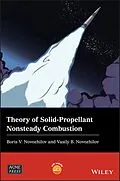Despite significant developments and widespread theoretical and practical interest in the area of Solid-Propellant Nonsteady Combustion for the last fifty years, a comprehensive and authoritative text on the subject has not been available.
Theory of Solid-Propellant Nonsteady Combustion fills this gap by summarizing theoretical approaches to the problem within the framework of the Zeldovich-Novozhilov (ZN-) theory. This book contains equations governing unsteady combustion and applies them systematically to a wide range of problems of practical interest. Theory conclusions are validated, as much as possible, against available experimental data.
Theory of Solid-Propellant Nonsteady Combustion provides an accurate up-to-date account and perspectives on the subject and is also accompanied by a website hosting solutions to problems in the book.
Autorentext
Professor Boris V. Novozhilov (1930-2017), Chief Researcher, The Semenov Institute of Chemical Physics, Russian Academy of Sciences, Moscow.
Professor Vasily B. Novozhilov, Professor of Mathematics, Discipline of Science, Research Institute for Sustainable Industries and Liveable Cities, Victoria University, Melbourne Victoria, Australia.
Klappentext
Theory of Solid-Propellant Nonsteady Combustion
The leading theoretical examination of solid-propellant nonsteady combustion
Theory of Solid-Propellant Nonsteady Combustion is the first authoritative and comprehensive monograph on the subject available to researchers and students of the field. This book contains equations governing unsteady combustion and applies them systematically to a wide range of practical problems. Theory conclusions are validated, as much as possible, against available experimental data. Theory of Solid-Propellant Nonsteady Combustion provides an accurate, up-to-date account of the subject. It is also accompanied by a website which provides solutions to the exercises found in the book.
Co-authored by one of the creators of the Zeldovich Novozhilov Theory the book includes, among others, discussions of:
- Combustion properties of solid propellants
- Fundamentals and mathematical formulation of the Zeldovich Novozhilov (ZN) Theory
- Combustion in steady and unsteady pressure environments
- Combustion beyond stability region
- Acoustic and non-acoustic combustion regimes, including extinction
- Extension of the Theory beyond conventional ZN approximations
Perfect for researchers and practitioners in the aerospace industry and graduate students in mechanical and aerospace engineering, this text provides a complete, fundamental, and invaluable resource to all those who work and study in the area.
Inhalt
About the Authors
Preface
Abbreviations
CHAPTER I STEADY-STATE COMBUSTION
1.1 General Characteristics of Solid Propellants
1.2 Burning Rate and Surface Temperature
1.3 Combustion Wave Structure.Burning temperature
1.4 Combustion in Tangential Gas Stream
1.5 Gaseous flame
1.6 Combustion Wave in Condensed Phase
1.7 The Two Approaches to the Theory of Nonsteady Propellant Combustion
1.8 Steady-State Belyaev Model
CHAPTER II EQUATIONS OF THE THEORY OF NONSTEADY COMBUSTION
2.1 Major Assumptions
2.2 Zeldovich Theory. Constant Surface Temperature
2.3 Variable Surface Temperature
2.4 Integral Formulation of the Theory
2.5 Theory Formulation through the set of Ordinary Differential Equations
2.6 Linear Approximation
2.7 Formal Mathematical Justification of the Theory
CHAPTER III COMBUSTION UNDER CONSTANT PRESSURE
3.1 Stability Criterion for a Steady-state Combustion Regime
3.2 Asymptotical Perturbation Analysis
3.3 Two-dimensional Combustion Stability of Gasless Systems
3.4 Combustion Beyond Stability Region
3.5 Comparison to Experimental Data
CHAPTER IV COMBUSTION UNDER HARMONICALLY OSCILLATING PRESSURE
4.1 Linear Burning Rate Response to Harmonically Oscillating Pressure
4.2 Acoustic Admittance of Propellant Surface
4.3 Quadratic Response Functions
4.4 Acoustic Admittance in the Second-order Approximation
4.5 Nonlinear Resonance
4.6 Response Function Bifurcations
4.7 Frequency Amplitude Diagram
4.8 Comparison to Experimental Data
CHAPTER V NONSTEADY EROSIVE COMBUSTION
5.1 Problem formulation
5.2 Linear Approximation
5.3 Nonlinear Effects in Nonsteady Erosive Combustion
CHAPTER VI NONSTEADY COMBUSTION UNDER EXTERNAL RADIATION
6.1 Steady-state Combustion Regime
6.2 Heat Transfer Equation in the Linear Approximation
6.3 Linearization of Nonsteady Burning Laws
6.4 Steady-state Combustion Regime Stability
6.5 Burning Rate Response to Harmonically Oscillating Pressure
6.6 Burning Rate Response to Harmonically Oscillating Radiative Flux
6.7 Relation between Burning Rate Responses to Harmonically Oscillating Pressure and Radiative Flux
CHAPTER VII NON-ACOUSTIC COMBUSTION REGIMES. EXTINCTION
7.1 Acoustic and Non-acoustic Combustion Regimes
7.2 Linear Approximation
7.3 Approximate Approach in the Theory of Nonsteady Combustion
7.4 Self-similar Solution
7.5 Self-similar Solution Stability
7.6 Propellant Combustion and Extinction under Depressurization.
Constant Surface Temperature.
7.7 Propellant Combustion and Extinction under Depressurization.
Variable Surface Temperature.
CHAPTER VIII MODELING NONSTEADY COMBUSTION IN SOLID ROCKET MOTOR
8.1 Introduction
8.2 Non-acoustic Regimes. Problem Formulation
8.3 Stability of Steady-state Regime in a Semi-enclosed Volume
8.4 Transient Regimes
8.5 Unstable and Chaotic Regimes
8.6 Experimental Data
8.7 Acoustic Regimes
8.8 Automatic Control of Propellant Combustion Stability in a Semi- enclosed Volume
CHAPTER IX INFLUENCE OF GAS-PHASE INERTIA ON NONSTEADY COMBUSTION
9.1 Introduction
9.2 Steady-state Combustion Regime Stability
9.3 Burning Rate Response to Harmonically Oscillating Pressure
9.4 Acoustic Admittance of Propellant Surface
9.5 Combustion and Extinction under Depressurization
9.6 approximation
References
Problems
Problem Solutions
Subject Index
